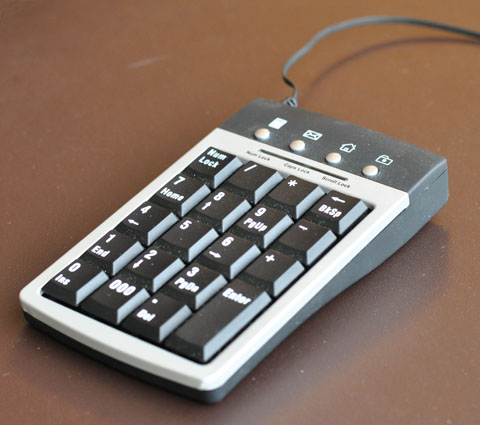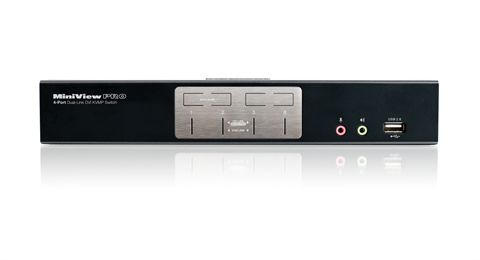I continually switch between my personal computer and my work laptop. Rather than physically move from one computer to another, I use a KVM switch. For those that do not know, KVM is short for “Keyboard, Video, Mouse”. By connecting one monitor, keyboard, and mouse to the output of the switch and multiple computers to the inputs, I can easily switch between computers by just changing the port number on the KVM. The computer that is connected to the active port of the KVM is able to access the monitor and receive input from the keyboard/mouse.
Modern KVMs are more than just physical switches, however. When a computer is connected but not on the active port, the KVM still has to regularly communicate with the computer to pretend that the devices are still connected. For instance, you do not want your video card to lose sync with the monitor and revert to a default small resolution, causing your desktop icons to reshuffle around! And to make life even easier, many KVM switches include “hotkey switching”, which allows you to type in a short sequence of keys on your keyboard to switch to a different port or even activate other options.
For the past few years, I have used one of the the Belkin SOHO KVM models. My specific model supported four computers using DVI for the monitors and USB for the keyboard/mouse, plus I could optionally connect other USB peripherals though a separate USB port on the KVM switch (which technical makes it a KVMP, where the “P” stands for “Peripherals”). Unfortunately, I have been having escalating issues with my KVM and I finally had to buy a new one.
My old Belkin KVM first started showing its age when it would not recognize my personal computer unless another computer was powered on and connected to the KVM, too. That also meant that I could not disconnect my work laptop without causing my personal computer to permanently lose sync with the KVM, which would force me to fiddle around behind my personal computer to unplug and reconnect the DVI connection to get the video working again (after I made sure another computer was running on the KVM, of course). Since I did not want to buy another KVM for such a small issue, I just made sure I always had another running computer connected to the KVM while my personal computer was running (which is always).
Then about a year ago I bought a mechanical keyboard. For some reason, none of my computers would recognize the keyboard when I plugged it into the correct USB slot of the KVM. I was finally able to get it to work by using the peripheral USB port of the switch, but hotkey switching no longer worked. I found an old USB numeric keypad and managed to get hotkey switching working by plugging that into the keyboard port, but now I had another item on my desk taking up space for no good reason. Still, I did not want to pay for another KVM.

Most recently, the KVM stopped recognizing my work laptop anytime I switched to another port. To get it working again, I always needed to unplug and then reconnect the video cable. So I found an obscure workaround (my work laptop runs on Linux and the workaround involved udev scripts; try looking them up and you will see what I mean by “obscure”), but then the KVM began to randomly change the resolution on all of my connected computers. While I was working, suddenly the screen would flash on and off a few times, and half of my windows would be stuck in a weird state because of the rapid resolution changes.
So I finally decided to get a new KVM switch. After shopping around, I found the IOGEAR GCS1204G, a four-port KVMP with USB and Dual-Link DVI support. The switch is one of their “Pro” models, which are supposed to be better at handling gaming keyboards and mice (my keyboard could be considered a gaming keyboard, although it doesn’t have any extra gaming buttons) plus it can handle higher maximum resolutions (up to 2560 x 1600). I might buy a new monitor next year and I do not want to be limited by my KVM.

So far, the IOGEAR is working great. Everything just worked after connecting all the cables, including my keyboard and hotkey switching. I was able to get rid of the numeric keypad, removing a little more clutter from my desk. And when I originally turned on my personal computer by itself, the KVM correctly identified the device without any problems.
After running it for a few days, I think the original source of the problems with the work laptop is from the laptop itself. Even with the new KVM, the work laptop occasionally causes the monitor to flash to black a few times, although now it does not change resolution. None of my other computers cause this to happen, so it appears that the IOGEAR is able to keep the video problems isolated to the single computer.
Overall, I am very pleased with this new replacement in my computer setup.
